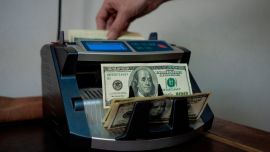Peso-greeback turbulence is back and heating up. On Wednesday, Argentina's parallel exchange rate went up by 45 pesos and closed at 1,275 pesos, when only 10 days ago it seemed to lie dormant at 1,050.
In the meantime, the so-called 'stock exchange' dollar also grew during the day and reached 1,230 pesos, while the CCL rate also went up by 5 percent to finish at 1,256 pesos. In merely a week, the 'blue' dollar rose by over 160 pesos and exceeded its previous maximum level of the year, recorded on January 24.
In a context of uncertainty Argentina's country risk rating has placed at nearly 1,400 points, when in early April it was slightly above 1,200. In the meantime, those criticising a delayed exchange rate depreciation, which the government assures will continue, are multiplying.
Some people are beginning to question other things too – will this dollar leap apply to prices? President Javier Milei's government, represented yesterday by Presidential Spokesperson Manuel Adorni, stated clearly that it will not happen and that inflation will continue to fall. Nevertheless, the waters are restless.
According to economist Elena Alonso from the Emerald Capital consultancy firm, investors start to resort to the dollar as a result of the abrupt drop of Central Bank interest rates.
Alonso pointed out two matters: “On the one hand, the situation of the failure to get as many dollars from exports and on the other hand, the fear that this dollar increase goes to prices after all the effort made by the government to lower inflation by means of the 'chainsaw' and through the recession."
She added: "That would seem to be senseless now if this continues to happen to the dollar and it is applied to prices, so there’s a budding caution when looking at Argentina."
In the same vein, Alonso added that another major point is the need for the government has to obtain legislative support. “It’s a permanente negotiation, but the things they want to turn out lie in the hope that they will turn out, but it needs more strength in that respect to be able to make changes,” she explained, referring to President Milei's attempt to push through sweeping reforms in Congress via its 'Ley de Bases' omnibus bill.
“I believe there is some pressure about the existing exchange rate, even if they do not wish to move the official exchange rate. If the gap widens, the expectations for a devaluation make more sense, and on the other hand, there is the fear of an increasing inflation. All of that makes the market move with the expectation that there isn’t much margin in my opinion," said the analyst.
Meanwhile, Gastón Lentini laid more emphasis on policy in this context. “The May Pact has fallen, rates have fallen, [provincial] governors are not being supportive and the 'Ley de Bases' [bill] is not coming out. The result is clearly increased uncertainty and nothing is more coward than money, which runs to take shelter, once again in the dollar thus causing the rise,” reflected the analyst.
In his view, “the particular thing about this which many wish to call a run, is that the Central Bank has purchased dollars and ended up with more reserves, unlike other times, where the ‘run’ happened due to a widespread increase in the demand for dollars draining the State coffers," said the author and analyst. "That is why I must first call for people to be calm."
Among other reflections, he added: “I think the rise of the dollar of the last few days is just one more adjustment which maybe happened late."




















Comments